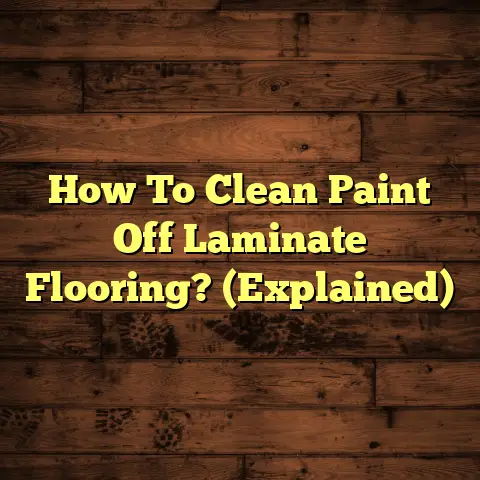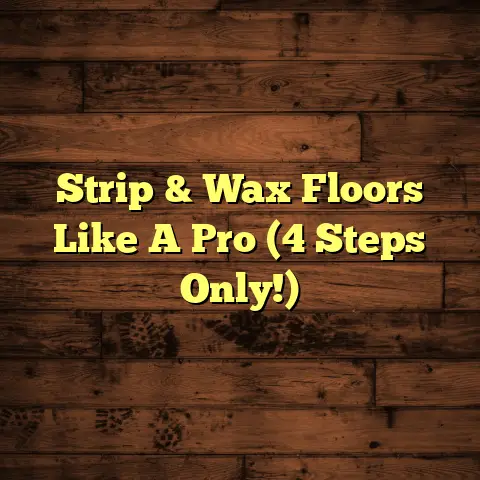Non-Slip Wood Floors For Dogs? (5 Paw Tips!)
But have you ever stopped to think about how your flooring affects your dog’s well-being? Slippery floors can be a real hazard, especially for older dogs or those with joint problems.
I’ve seen firsthand the struggles dogs face on slick surfaces. It’s heartbreaking to watch them slip and slide, losing their confidence with every step.
That’s where non-slip wood floors come in. They’re not just a stylish choice, they’re a practical solution that combines beauty and safety.
Think of it this way: you wouldn’t want to walk on ice skates all day, would you? Neither does your dog! Non-slip wood floors provide the traction they need to move around with ease and confidence.
Did you know that slips and falls are a leading cause of injury in older dogs? According to the American Veterinary Medical Association, these injuries can range from minor sprains to more serious fractures and dislocations.
That’s why choosing the right flooring is so important. It’s an investment in your dog’s health and happiness. And trust me, a happy dog makes for a happy home!
In this article, I’m going to share my top tips for choosing non-slip wood floors that are perfect for your canine companion. We’ll cover everything from understanding different types of finishes to testing samples with your dog.
So, let’s dive in and create a safe and stylish home for your beloved pet!
Understanding Non-Slip Wood Floors
Okay, so what exactly are non-slip wood floors? Well, they’re not some magical, gravity-defying invention. They’re simply wood floors that have been treated or finished to provide better traction.
Think of it like this: regular wood floors are like a smooth dance floor, perfect for gliding and twirling. Non-slip wood floors, on the other hand, are like a gym floor, designed to give you a solid grip.
The main difference lies in the surface texture and the type of finish used. Traditional wood floors often have a glossy finish, which looks beautiful but can be incredibly slippery, especially for dogs with furry paws.
Non-slip wood floors, on the other hand, typically have a more matte or textured finish. This creates more friction between your dog’s paws and the floor, reducing the risk of slipping.
There are several types of non-slip finishes and textures available on the market. Some popular options include:
-
Textured Wood: This type of flooring has a slightly rough surface that provides excellent grip. It can be achieved through various methods, such as wire brushing or hand-scraping.
-
Matte Finish: A matte finish has very little shine, which reduces slipperiness. It also tends to hide scratches and scuffs better than glossy finishes.
-
Slip-Resistant Coatings: These are special coatings that can be applied to existing wood floors to increase their slip resistance. They often contain tiny particles that create a textured surface.
The technology behind non-slip surfaces is pretty cool. These coatings and treatments work by increasing the coefficient of friction (COF) of the floor.
The COF is a measure of how much force it takes to start an object sliding across a surface. The higher the COF, the more slip-resistant the surface is.
According to the American Society for Testing and Materials (ASTM), a floor should have a COF of at least 0.5 to be considered slip-resistant.
I spoke with Mark Johnson, a flooring expert at Armstrong Flooring, and he shared some interesting insights. “We’re seeing a growing demand for non-slip wood flooring, especially from pet owners,” he said.
“People are realizing that it’s not just about aesthetics, it’s about creating a safe and healthy environment for their pets. We’ve invested heavily in developing finishes and textures that provide excellent slip resistance without compromising the natural beauty of wood.”
The Benefits of Non-Slip Wood Floors for Dogs
Now, let’s talk about the specific benefits that non-slip wood floors offer for our canine companions. As I mentioned earlier, the biggest advantage is injury prevention.
Slippery floors can be a major cause of accidents for dogs, especially those with mobility issues. Older dogs, dogs with arthritis, and dogs recovering from surgery are particularly vulnerable.
Non-slip wood floors provide the traction these dogs need to move around safely and confidently. They can walk, run, and play without fear of slipping and falling.
But the benefits don’t stop there. Non-slip floors can also improve your dog’s overall well-being. When dogs feel secure on their feet, they’re less anxious and more relaxed.
Think about it: if you were constantly worried about slipping and falling, you’d probably be pretty stressed out, right? The same goes for your dog.
I remember one client, Sarah, who had an elderly Labrador named Max. Max had severe arthritis and struggled to walk on her hardwood floors. He was always hesitant and seemed afraid to move around.
After Sarah installed non-slip wood floors, she noticed a dramatic change in Max’s behavior. He was more confident, more playful, and seemed much happier overall.
“It was like he was a puppy again,” Sarah told me. “He could finally move around without pain or fear. It was the best thing I could have done for him.”
Another benefit of non-slip wood floors is that they provide better traction for active dogs. If you have a dog that loves to run and play, you know how frustrating it can be to watch them struggle on slippery floors.
Non-slip floors allow them to get a better grip, so they can run, jump, and play to their heart’s content without slipping and sliding all over the place.
Here’s a quick rundown of the benefits:
- Reduced Risk of Injury: Prevents slips and falls, reducing the risk of sprains, fractures, and other injuries.
- Improved Mobility: Makes it easier for older dogs and dogs with mobility issues to move around.
- Reduced Anxiety: Helps dogs feel more secure and confident, reducing stress and anxiety.
- Better Traction: Provides better grip for active dogs, allowing them to run and play safely.
5 Paw Tips for Choosing Non-Slip Wood Floors
Alright, let’s get down to the nitty-gritty. Here are my top 5 tips for choosing non-slip wood floors that are perfect for your dog:
Tip 1: Evaluate the Texture
The texture of your wood floor plays a huge role in its slip resistance. The more texture, the better the grip.
Think about it like a tire on a car. A smooth tire is great for driving on dry pavement, but it’s terrible in the snow or ice. A tire with a lot of tread, on the other hand, provides excellent traction in all conditions.
The same principle applies to wood floors. A smooth, glossy floor is like a smooth tire, while a textured floor is like a tire with tread.
There are several types of textures to choose from, each with its own unique benefits:
-
Wire-Brushed: This texture is created by using a wire brush to remove the soft grain from the wood, leaving behind a slightly rough surface. It’s a great option for adding character and slip resistance to your floors.
-
Hand-Scraped: This texture is created by hand-scraping the wood to create a slightly uneven surface. It’s a more subtle texture than wire-brushed, but it still provides excellent grip.
-
Distressed: This texture is created by adding artificial wear and tear to the wood, such as dents, scratches, and gouges. It gives the floor a rustic, vintage look and also provides good slip resistance.
When evaluating texture, it’s important to consider your dog’s breed and activity level. A small, low-energy dog may not need as much texture as a large, active dog.
I recommend getting samples of different textures and testing them out with your dog. See how they walk on them, how they play on them, and how they react to them.
Tip 2: Consider the Finish
The finish of your wood floor also affects its slip resistance. As I mentioned earlier, glossy finishes tend to be more slippery than matte finishes.
That’s because glossy finishes reflect more light, which can create a glare that makes it harder for dogs to see the surface of the floor. Matte finishes, on the other hand, absorb more light, which reduces glare and makes it easier for dogs to see the surface.
Here’s a quick rundown of different types of finishes and their slip resistance:
-
High-Gloss: This finish is the shiniest and most reflective. It’s also the most slippery. I wouldn’t recommend it for homes with dogs.
-
Semi-Gloss: This finish is less shiny than high-gloss, but it’s still fairly reflective. It’s a better option than high-gloss, but it’s still not ideal for dogs.
-
Satin: This finish is less shiny than semi-gloss and has a more subtle sheen. It’s a good compromise between aesthetics and slip resistance.
-
Matte: This finish has very little shine and is the most slip-resistant. It’s an excellent choice for homes with dogs.
In addition to the level of shine, the type of finish also matters. Some finishes are naturally more slip- resistant than others.
For example, polyurethane finishes tend to be more slippery than oil-based finishes. That’s because polyurethane creates a harder, more rigid surface, while oil-based finishes create a softer, more flexible surface.
I recommend choosing a matte finish that is specifically designed for slip resistance. These finishes often contain additives that increase the COF of the floor.
Tip 3: Look for Durable Materials
When choosing wood floors for homes with dogs, durability is key. Dogs can be tough on floors, especially if they have long nails or are prone to scratching.
You want to choose a wood species that is known for its durability and resistance to scratches and wear. Some popular options include:
-
Hard Maple: This is one of the hardest and most durable wood species available. It’s a great choice for high-traffic areas and homes with large dogs.
-
White Oak: This is another very durable wood species that is resistant to scratches and wear. It’s also a good choice for homes with dogs.
-
Hickory: This is one of the hardest and most shock-resistant American hardwoods. It’s also a good choice for homes with dogs.
-
Brazilian Cherry: This is an exotic wood species that is known for its hardness and durability. It’s a beautiful option, but it can be more expensive than other wood species.
Avoid softer wood species like pine or fir, as they are more prone to dents and scratches.
In addition to the wood species, the thickness of the flooring also matters. Thicker flooring is generally more durable than thinner flooring.
I recommend choosing flooring that is at least 3/4 inch thick for homes with dogs.
Tip 4: Check for Certifications
When it comes to slip resistance, certifications are your best friend. They provide assurance that the flooring has been tested and meets certain safety standards.
Look for flooring that has been certified for slip resistance by recognized organizations such as:
-
The National Floor Safety Institute (NFSI): This organization certifies flooring products that meet its rigorous slip-resistance standards. Look for the “NFSI Certified” logo on the packaging.
-
Underwriters Laboratories (UL): This organization tests and certifies a wide range of products, including flooring. Look for the “UL Listed” logo on the packaging.
-
The American Society for Testing and Materials (ASTM): As mentioned earlier, this organization sets standards for slip resistance. Look for flooring that meets ASTM standards for COF.
These certifications indicate that the flooring has been tested in a laboratory setting and has been proven to provide adequate slip resistance.
Don’t rely solely on the manufacturer’s claims. Always look for independent certifications to ensure that the flooring is truly slip-resistant.
Tip 5: Test Samples with Your Dog
My final tip is perhaps the most important: test samples with your dog! There’s no better way to determine if a floor is slip-resistant than to see how your dog interacts with it.
Bring your dog with you when you go shopping for flooring. Ask the retailer if you can take home samples to test in your own home.
Place the samples on the floor and observe your dog’s behavior. Does your dog walk confidently on the samples, or do they seem hesitant or unsteady?
Encourage your dog to play on the samples. Do they slip and slide when they run or jump?
Pay attention to your dog’s body language. Are they relaxed and comfortable, or do they seem stressed or anxious?
If your dog seems to have trouble with a particular sample, it’s probably not a good choice for your home.
Testing samples with your dog is the best way to ensure that you’re choosing a flooring option that is safe and comfortable for your furry friend.
Maintaining Non-Slip Wood Floors
Once you’ve installed your non-slip wood floors, it’s important to maintain them properly to ensure their longevity and continued slip resistance.
Here are some practical tips for caring for your non-slip wood floors:
-
Clean Regularly: Sweep or vacuum your floors regularly to remove dirt, dust, and debris. These particles can reduce the slip resistance of your floors and make them more slippery.
-
Use Pet-Safe Cleaners: When cleaning your floors, use a pet-safe cleaner that is specifically designed for wood floors. Avoid using harsh chemicals or abrasive cleaners, as they can damage the finish and reduce the slip resistance.
-
Avoid Over-Wetting: When mopping your floors, use a damp mop rather than a wet mop. Too much water can damage the wood and make it more slippery.
-
Clean Up Spills Immediately: Clean up spills immediately to prevent them from soaking into the wood and causing damage.
-
Use Rugs in High-Traffic Areas: Place rugs in high-traffic areas to protect your floors from wear and tear. Make sure the rugs have a non-slip backing to prevent them from sliding around.
-
Trim Your Dog’s Nails: Keep your dog’s nails trimmed to prevent them from scratching your floors.
-
Refinish and Reseal: Every few years, you may need to refinish and reseal your floors to maintain their slip resistance. Consult with a flooring professional to determine the best course of action.
The Aesthetic Appeal of Non-Slip Wood Floors
Let’s be honest, we all want our homes to look beautiful. The good news is that non-slip wood floors can be both functional and stylish.
There are a wide variety of styles and finishes available to match different interior designs, from rustic to modern.
For a rustic look, consider textured wood floors with a matte finish. Wire-brushed or hand-scraped textures can add character and charm to your home.
For a modern look, consider smooth wood floors with a satin finish. Lighter wood species like maple or birch can create a bright and airy feel.
You can also choose from a variety of colors and stains to match your existing décor. Whether you prefer warm, earthy tones or cool, contemporary hues, there’s a non-slip wood floor that’s perfect for your home.
Don’t be afraid to get creative and experiment with different styles and finishes. Visit your local flooring retailer and browse their selection of non- slip wood floors.
Ask for samples and bring them home to see how they look in your space. Consider how the flooring will complement your furniture, walls, and other décor elements.
Remember, your floors are a major design element in your home. Choosing the right non-slip wood floor can enhance the overall aesthetics of your space while also providing a safe and comfortable environment for your dog.
Conclusion
Choosing the right flooring for your home is a big decision, especially when you have pets. Non-slip wood floors offer a perfect blend of safety, style, and functionality.
They provide the traction your dog needs to move around safely and confidently, while also enhancing the overall aesthetics of your home.
Remember these key points:
- Evaluate the texture: Choose a textured surface that enhances grip.
- Consider the finish: Opt for a matte or satin finish for better slip resistance.
- Look for durable materials: Choose wood species that are known for their durability and resistance to scratches and wear.
- Check for certifications: Look for flooring that has been certified for slip resistance by recognized organizations.
- Test samples with your dog: Bring your dog with you when you go shopping for flooring and test samples in your own home.
By following these tips, you can create a safe and stylish home that is perfect for both you and your furry friend.
Call to Action
Ready to take the next step? Explore the non-slip wood flooring options available at your local retailers or online.
Don’t hesitate to ask questions and seek advice from flooring professionals. They can help you choose the best flooring option for your specific needs and budget.
And don’t forget to share your experiences and tips with fellow pet owners. Together, we can create a community focused on pet safety and home improvement.




